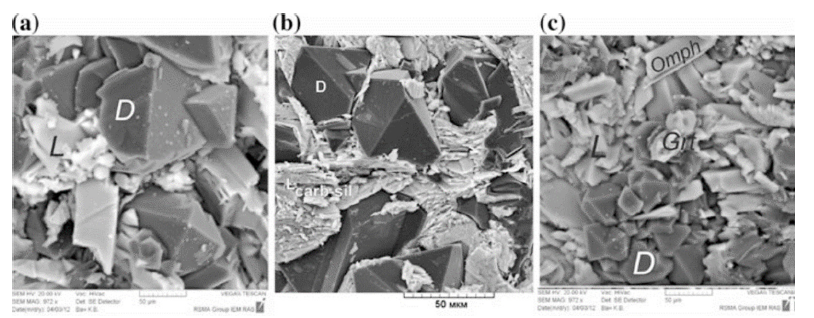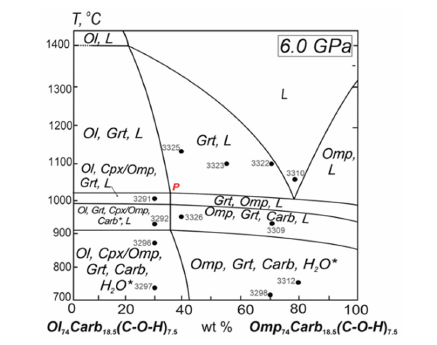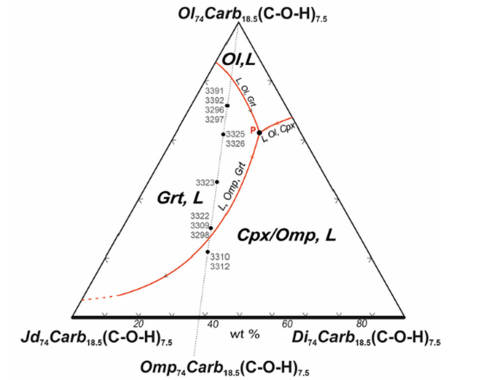- Submissions

Full Text
Aspects in Mining & Mineral Science
The Problems Revealed on a Basis of the Mantle-Carbonatite Theory of Diamond Genesis
Yuriy Litvin*
D S Korzhinsky Institute of Experimental Mineralogy (Russian Acad Sci), Russia
*Corresponding author:Yuriy Litvin, D S Korzhinsky Institute of Experimental Mineralogy (Russian Acad Sci), Academ Osipyan Str. 4, Chernogolovka, Moscow District, 142432, Russia
Submission: September 15, 2023: Published: December 08, 2023

ISSN 2578-0255Volume12 Issue1
Abstract
High-pressure experimental studies make it possible to determine the completely miscible silicate-carbonate melts with dissolved carbon as the parental media for diamonds. Physico-chemically the genesis of diamonds and associated phases is unraveled in the mantle-carbonatite theory. Its effectivity is illustrated with the experimental study at 6GPa of the diamond-forming system peridotite/eclogite-carbonate-(C-O-H-fluid). This research has resulted in the discovery of the peritectic reaction of olivine and jadeite-bearing melts with formation of garnet. Only this reaction provides an ultrabasic-basic evolution of the melts with transfer from the diamond-bearing peridotites to eclogites (in conditions of the melts fractional crystallization under the Earth’s gravitation field). The mantle-carbonatite theory will also allow an understanding of the genesis of the unique Matryoshka-type diamond that is of interest as the diamond-host having a closed empty cavity inside of which the movable diamond-inclusion is revealed.
Keywords:Diamond origin; Mantle-carbonatite theory; Ultrabasic-basic evolution; Olivine peritectic reaction; Metastable graphite; Origin on unique Matryoshka-type diamond
Introduction
The mantle-carbonatite theory is substantiated with mineralogical and experimental data and reveals the physico-chemical mechanisms of genesis of diamonds and associated mineral phases at the Earth’s mantle conditions [1]. Diamonds of kimberlite and lamproite deposits have been formed under PT-conditions of the upper mantle in chambers of the peridotite-carbonate and eclogite-carbonate melts-solutions of carbon with the admixture components of the (C-O-H)-fluid. The metasomatic carbonatization of the mantle minerals by СО2-component of the ascending streams of the supercritical C-O-H-fluids is of significance in the initiation of the diamond-forming systems and their chambers (Figure 1). As a result, the carbonate melts which are dissolved the mantle silicates and generate the completely miscible silicate-carbonate melts. This carbonate and silicate-carbonate melts are very effective solvents of the mantle metastable graphite. With graphite dissolution the silicate-carbonate melts, oversaturated to diamond with carbon, are created. The melt-solution are capable of mass nucleation and crystal growth of diamonds. The ultrabasic and basic compositions of these melts-solutions of carbon must correspond to the criterium of the diamonds and inclusions syngenesis [2]: to be capable to a growth capturing by diamonds both the paragenetic and xenogenetic minerals which are detected in the natural diamonds. The main stages in the formation of diamond deposits [3-5]: [1] origin of the upper mantle chambers of silicate-carbonate-carbon melts (150-250km, 4.5-7.5GPa); [2] mass growth of diamonds with the capture of syngenetic minerals; [3] transport by kimberlite magmas of the diamonds and associated phases with formation of the cumulative chambers at the Earth’s crust; [4] generating of a highly compressed gas-fluid C-O-H phase at solidification of kimberlite melts in cumulative chambers and “fluid drilling” of the solid roof; [5] formation of diamond deposits in the kimberlite explosive pipes. Here it is given a brief overview of the progress in development and application of the mantle-carbonatite theory of genesis of diamonds and associated mineral phases.
Figure 1:Experimental samples of the eclogite-carbonate system (Ecl40Carb60-C) after quenching: (a,b)- liquidus crystallization of diamond (D) where L for completely miscible clogite-carbonate melt; (c)-paragenetic crystallization of diamond with omphacite (Omph) and garnet (Grt) [1].

Garnet-Forming Olivine Peritectic Reaction
Melting relations of the diamond-forming olivine–jadeite– diopside–carbonates–(C-O-H-fluid) system are studied in experiments at 6.0GPa in the polythermal Ol74Carb18.5(C-O-H)7.5- Omp74Carb18.5(C-O-H)7.5 section, where Ol=Fo80Fa20, Omp=Jd62Di38 and Carb=(MgCO3)25(FeCO3)25(CaCO3)25(Na2CO3)25 [3]. The peritectic reaction of olivine and jadeite-bearing melts with formation of garnet has been determined as a physico-chemical mechanism of the ultrabasic–basic evolution of the diamondforming system [4]. During the process, the CO2 component of the supercritical C-O-H-fluid can react with silicate components to form additional carbonates of Mg, Fe, Ca and Na (Figure 2a). The solidus temperature of the diamond-forming system is lowered to 1000–1020 °C by the joint effect of the H2O fluid and its carbonate constituents. The experimentally recognized peritectic mechanism of the ultrabasic–basic evolution of the diamond-forming system explains the origin of associated paragenetic inclusions of peridotite and eclogite minerals in diamonds, as well as the xenoliths of diamond-bearing peridotites and eclogites of kimberlitic deposits of diamond. Diamond-forming systems have formed with the use of material from upper mantle native peridotite rocks. In this case, the capacity of the rocks to initiate the peritectic reaction of olivine was transmitted with silicate components to diamond-forming systems (Figure 2b).
Figure 2a:Melting relations of the ultrabasic–basic diamond-forming Ol-Jd–Di–Carb–(C-O-H-fluid) system in its Ol74Carb18.5(C-O-H)7.5–Omp74Carb18.5(C-O-H)7.5 polythermal section at 6.0GPa. Symbols: P, peritectic point, L, melt;Ol, olivine; Fo, forsterite; Fa, fayalite; Omp, omphacite; Grt, garnet; carb, carbonates; H2O*, supercritical water. Numbered points correspond to experimental compositions (in the table of [4]).

Figure 2b:The peritectic point P of the ultrabasic–basic diamond-forming olivine (Ol)–jadeite (Jd)– diopside (Di)– carbonates (Carb)-(C-O-H-fluid) system at 6GPa. The position of the polythermal section Ol74Carb18.5(C-O-H)7.5 – Omp74Carb18.5(C-O-H)7.5 is shown by the dotted line (symbols: L, melt; Ol, olivine; Cpx, clinopyroxene; Omp, omphacite; Grt, garnet; Carb, Mg-Fe-Ca-Na-carbonate mix. Numbered black points are experimental compositions) in the table of [4].

How Matryoska-Type Diamond is Formed
A physicochemical analysis of the genesis of a unique Matryoshka-type diamond from the Nyurbinskaya kimberlite pipe of Yakutia, Russia, was performed [5]. The specimen consists of a host diamond with a cavity containing a loose diamond inclusion; two through holes with a width of 0.1-0.4mm emerge from the cavity. As a result, the crystallization of the host diamond with a cavity and diamond inclusion under the conditions of mass genesis of diamonds in completely miscible eclogite-carbonatecarbon melts of the upper-mantle diamond-forming chamber are substantiated. The initially closed cavity was filled with a diamondforming eclogite-carbonate melt with dissolved carbon, and, after its solidification, with Mg, Fe, Ca and Na carbonates, omphacite, garnet and coesite, as well as metastable microgranular graphite and sulfides. After millions of years, a rather rapid kimberlite capture took place in a consolidated diamond-forming chamber and the carbonate-containing substance with diamonds was transported to the Earth’s crust (Figure 3). The diamond-forming substance in the cavity melted. This process was accompanied by partial dissolution of diamonds, including the host diamond and inclusions. The decrease in pressure upon the transportation resulted in the incongruent decomposition of Mg- and Fe-carbonates into oxides and CO2 with C-O-H fluidization of kimberlite magma and assimilated matter. Two through holes were formed explosively under the conditions of significant pressure difference between the cavity of the host diamond and its surface. This was accompanied by the ejection of the parental melt from the cavity into which the C-O-H fluid-bearing kimberlite melt penetrated. The final episodes of partial dissolution of diamonds from the Matryoshka sample by kimberlite and assimilated melts continued during the formation of a cumulative chamber in the Earth’s crust and its solidification with the release of a highly compressed C–O–H fluid. “Fluid drilling” of the top of the cumulative chamber stimulated the explosive formation of the Nyurbinskaya pipe and its filling with kimberlite and assimilated diamondiferous matter. With prolonged compaction of this substance, the Matryoshka diamond was subjected to atmospheric and hydrothermal factors, as is evidenced by fine-grained sedimentary barite, a mineral of barium sulphate BaSO4 found in the through holes of the host diamond.
Figure 3:General view of the Matryoshka diamond sample containing a diamond inclusion with visible boundaries. Video filming by JSC ALROSA (Siberian Times 2019. Matryoshka diamond. YouTube).

Conclusion
The origin of the parental silicate-carbonate-(C-O-H)-C melts for the diamond-bearing peridotites and eclogites as well as the main stages in the formation of diamond deposits in kimberlite pipes are presented. The peritectic reaction of olivine and jadeitebearing melts with formation of garnet has been experimentally determined at 6GPa as a physico-chemical mechanism of the fractional ultrabasic-basic evolution of the diamond-forming systems. The mechanism is responsible for the consecutive genesis of diamond-bearing peridotites and eclogites as well as of the paragenic ultrabasic and basic mineral inclusions in diamonds. The origin of the Matryoshka diamond sample is interpreted on the basis of the mantle-carbonatite theory of the formation of natural diamonds and associated paragenic and xenogenic mineral phases.
References
- Litvin YA (2017) Genesis of diamonds and associated phases. Springer, p. 137.
- Litvin YA (2007) High-pressure mineralogy of diamond genesis. In: Ohtani E (Ed.), Advances in high-pressure mineralogy. Geol Soc Am Sp 121: 83-103.
- Litvin YA, Kuzyura AV, Varlamov DA, Bovkun AV, Spivak AV, et al. (2020) Genesis of diamondiferous rocks from upper-mantle xenolith in kimberlite. Geochemistry International 58(3): 245-270.
- Litvin YA, Kuzyra AV, Spivak AV (2023) The peritectic reaction of olivine as the mechanism of the ultrabasic-basic evolution of the diamond-forming silicate-carbonate-(C-O-H) system: experiments at 6.0 GPa. Minerals 13(8): 1040.
- Litvin YA (2023) Physicogeochemical mechanisms of the genesis of Matryoshka-type diamonds on the basis of the mantle-carbonatite theory. Geochemistry International 61(3): 238-251.
© 2023 Yuriy Litvin. This is an open access article distributed under the terms of the Creative Commons Attribution License , which permits unrestricted use, distribution, and build upon your work non-commercially.
 a Creative Commons Attribution 4.0 International License. Based on a work at www.crimsonpublishers.com.
Best viewed in
a Creative Commons Attribution 4.0 International License. Based on a work at www.crimsonpublishers.com.
Best viewed in 







.jpg)






























 Editorial Board Registrations
Editorial Board Registrations Submit your Article
Submit your Article Refer a Friend
Refer a Friend Advertise With Us
Advertise With Us
.jpg)






.jpg)














.bmp)
.jpg)
.png)
.jpg)










.jpg)






.png)

.png)



.png)






